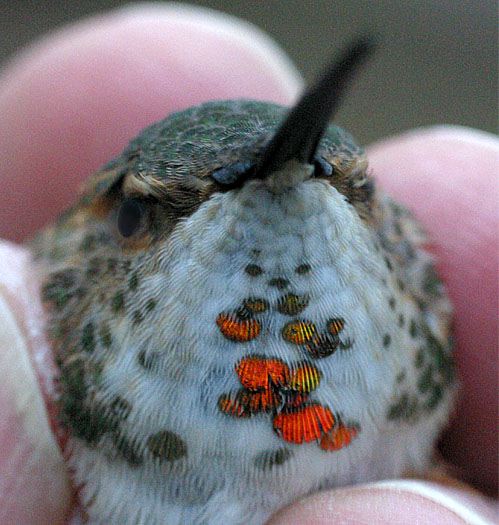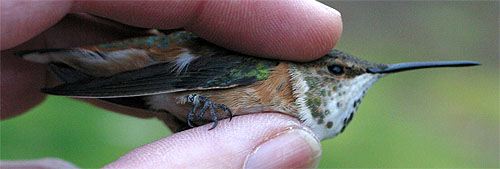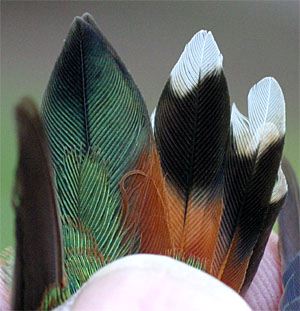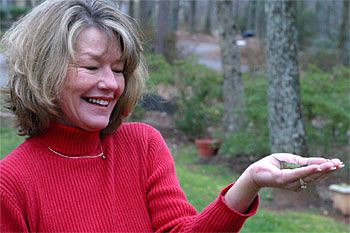|
|
|||
|
All text & photos © Hilton Pond Center Mary Hollingsworth is an avid summer feeder of Ruby-throated Hummingbirds at her place in Pickens (Pickens County), South Carolina, but she was surprised when--after all the the ruby-throats left in the autumn of 2003--another hummer showed up suddenly on about 11 November. Mary kept the artificial nectar in her feeder clean and fresh, and she was pleased to see that the late hummingbird continued to visit during December and on into the new year. Mary even rigged a small lamp that she turned on to keep the feeder juice warm during the day; likewise, she was careful to bring the feeder indoors at night to prevent it from freezing, and she always put it back out by 7 a.m. the next morning in time for the hummer's breakfast. In late January--after reading in the local newspaper an article about a Rufous Hummingbird we banded just up the road in Dacusville--Mary was quick to give us a call about the bird that had been hanging out all winter at her residence. We made plans to travel to Pickens on 26 January, but a significant ice storm waylaid our plans until after Groundhog Day. Finally, we arranged to travel on 4 February from Hilton Pond Center to Greenville SC, where we spent the night in anticipation of making a shorter trip to nearby Pickens the next day.
We were eager to get to Pickens by 7 a.m. because of what Mary had told us about her hummingbird's behavior: The bird ALWAYS made its first feeding trip at EXACTLY 7:20 a.m. regardless of whether the day was sunny or overcast. The latter was certainly the case on 5 February: dark, cloudy skies with impending rain, cold temperatures in the mid-30s, and gusty winds out of the north. After getting to Mary's, we braved this inclement weather, moved her feeder into our portable hummingbird trap, and--with rapidly stiffening fingers--we hung the apparatus in its usual place. A check of our watch showed everything was set by 7:08 a.m., so we quickly went onto Mary's screen porch and sat down where we had a good view of the trap. It was a short wait. Just as Mary predicted, the hummer showed up at PRECISELY 7:20 a.m., flew directly into the trap even though it was swaying in the wind, and perched on the enclosed feeder. We were quick to hit the transmitter button on our new but now-reliable release mechanism, and Mary was delighted to see the trapdoor slide shut behind her winter guest.
Rusty color in the tail and a few iridescent feathers on the throat suggested this was a Selasphorus hummingbird--either a Rufous or an Allen's--and the bird's general appearance made us think it was an adult female. After removing the hummer from the trap, we took it indoors for measurements that helped us conclude it was indeed a large and healthy female Rufous Hummingbird, S. rufus, that likely hatched out in southern Alaska, western Canada, or the northwestern U.S. prior to the 2003 breeding season.
After banding Mary's Rufous, we quickly set up our tripod and digital camera and tried to take our usual close-ups of the bird. Poor light, wind, and cold all worked against us, but we still managed to photographically document the bird as shown here. When we finished clicking the shutter, Mary got to hold the hummer, which she released as we hurriedly packed up our trap and banding gear. Although Mary was a gracious host, we wanted to get away from her Pickens residence as fast as possible and head 20 miles east toward Berea SC, where we had been told yet another winter hummingbird was waiting.
. . All text & photos © Hilton Pond Center
On to the account of the next banding at Berea SC.
If you're interested in sharing your hummingbird observations and learning from other enthusiasts, you may wish to subscribe to Hummingbird Hobnob, our Yahoo!-based discussion group. Also be sure to visit our award-winning Web site for Operation RubyThroat: The Hummingbird Project; on it you'll find almost anything you want to know about hummingbirds, including more information about Hummingbird Banding.
For much more information about hummingbirds, visit: |
|
Make direct donations on-line through
Network for Good: |
|
|
LIKE TO SHOP ON-LINE?
Donate a portion of your purchase price from 500+ top on-line stores via iGive: |
|
|
Use your PayPal account
to make direct donations: |
|
|
Back to Vagrant & Winter Hummingbird Banding Back to This Week at Hilton Pond Back to What's New? Current Weather Conditions at Hilton Pond Center |
 post questions for The Piedmont Naturalist |
Join the |
Search Engine for |
|
|





 Vital Statistics for
Vital Statistics for

 Students at GLOBE-certified schools may submit winter hummingbird observations as part of Operation RubyThroat and GLOBE. Students can also correlate hummingbird observations with data on abiotic factors, including atmosphere, climate, hydrology, soils, land cover, and phenology. See the
Students at GLOBE-certified schools may submit winter hummingbird observations as part of Operation RubyThroat and GLOBE. Students can also correlate hummingbird observations with data on abiotic factors, including atmosphere, climate, hydrology, soils, land cover, and phenology. See the 


